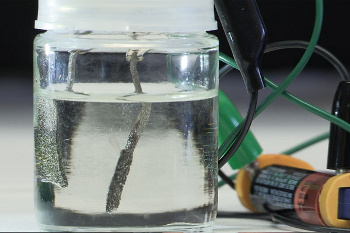
Splitting Water Inexpensively
September 12, 2014 Since the product of hydrogen combustion is just water, it should make an excellent motor vehicle fuel. Hydrogen has an energy density for combustion of 142 kJ/gram, which is quite a bit more than that for gasoline, 46.9 kJ/gram. One reason why hydrogen-fueled vehicles have not caught fire (wrong choice of words!) is that there are many problems with a "hydrogen economy." The first problem is production of hydrogen. Sure, you can make hydrogen simply by the electrolysis of water, but that electricity needs to be generated, somehow. If electricity for such electrolysis was generated by a coal-fired power plant, that would be environmentally unacceptable. However, photovoltaics could be used, and the direct use of sunlight for water-splitting, photolysis, permits the direct production of hydrogen using solar energy. I wrote about photolysis in several previous articles (Titania Photocatalysis, February 16, 2011, Manganese Photolysis of Water, June 1, 2011, and Water Photolysis by Antimony-Doped Gallium Nitride, September 1, 2011). Once you have the hydrogen, further problems arise. You need to store the hydrogen as it's produced, either by gas compression, liquefaction, or chemically, move it to where vehicles will fuel, and store it in those vehicles. Metal hydrides are one proposed method of chemical storage, but metals are heavy. However, as I told one of my professors many years ago, if it wasn't for little problems like this, we scientists would be out of a job. The problems of the hydrogen economy notwithstanding, research on more efficient methods of photolysis proceeds apace. Recently, an international team of scientists from Stanford University (Stanford, California), Oak Ridge National Laboratory (Oak Ridge, Tennessee) the National Taiwan University of Science and Technology (Taipei, Taiwan), Canadian Light Source Inc. (Saskatoon, Saskatchewan, Canada), and the University of Tennessee (Knoxville, Tennessee), have advanced the state of the electrolysis art by inventing non-precious metal electrodes that are suitable for low voltage water-splitting.[1-3] The key to an efficient electrolysis cell is a good electrode material. The best electrode for electrolysis is platinum, since it will produce hydrogen at a low voltage. Platinum, however, is too expensive, so other electrocatalyst materials must be used, often with disappointing results. The new electrode material of the present work is a nanoscale nickel oxide/nickel heterostructure formed on the sidewalls of carbon nanotubes. The nanotubes are grown on iron. This electrode was found to function nearly as well as platinum.[1] | A benchtop electrolysis cell powered by a single AAA alkaline battery. The bubbles of hydrogen and oxygen verify operation. (Stanford University photo by Mark Shwartz.)[2] |
"Using nickel and iron, which are cheap materials, we were able to make the electrocatalysts active enough to split water at room temperature with a single 1.5-volt battery... This is the first time anyone has used non-precious metal catalysts to split water at a voltage that low. It's quite remarkable, because normally you need expensive metals, like platinum or iridium, to achieve that voltage... When we found out that a nickel-based catalyst is as effective as platinum, it came as a complete surprise."[2]This electrode was discovered by Ming Gong, a graduate student at Stanford. As often happens in science, the precise mechanism for its excellent electrolysis properties is not yet known. Says Dai, "...we still don't fully understand the science behind it."[2] The low operating voltage is important, since it reduces the amount of power needed to effect the water-splitting. This translates to billions of dollars in savings in a full hydrogen economy and a huge environmental benefit.[2] The material still needs to be optimized to enhance its durability.[2] Says Dai, ""The current device would probably run for days, but weeks or months would be preferable. That goal is achievable based on my most recent results."[2] In addition to its use in electrolysis, this electrode material might also be used in the production of chlorine gas and sodium hydroxide.[2]
 | A fuel cell electric vehicle with photovoltaic panels in the background. (Still image from a Stanford University/ Precourt Institute for Energy YouTube video by Mark Shwartz, August 19, 2014.)[3] |
References:
- Ming Gong, Wu Zhou, Mon-Che Tsai, Jigang Zhou, Mingyun Guan, Meng-Chang Lin, Bo Zhang, Yongfeng Hu, Di-Yan Wang, Jiang Yang, Stephen J. Pennycook, Bing-Joe Hwang, and Hongjie Dai, "Nanoscale nickel oxide/nickel heterostructures for active hydrogen evolution electrocatalysis," Nature Communications, vol. 5, article no. 4695, August 22, 2014, doi:10.1038/ncomms5695.
- Mark Shwartz, "Stanford scientists develop water splitter that runs on ordinary AAA battery," Stanford Report, August 22, 2014.
- Mark Shwartz, "Stanford scientists develop low-cost water splitter," Stanford University/Precourt Institute for Energy YouTube video, August 19, 2014. Available, also, at the Stanford University Web Site.
- Michael J. Kenney, Ming Gong, Yanguang Li, Justin Z. Wu, Ju Feng, Mario Lanza, and Hongjie Dai, "High-Performance Silicon Photoanodes Passivated with Ultrathin Nickel Films for Water Oxidation," Science, vol. 342, no. 6160 (November 15, 2013), pp. 836-840.
- John A. Turner, "Perspective - A Nickel Finish Protects Silicon Photoanodes for Water Splitting," Science, vol. 342, no. 6160 (November 15, 2013), pp. 811-812.
- Mark Shwartz, "Stanford scientists create a low-cost, long-lasting water splitter made of silicon and nickel," Stanford Report, November 14, 2013.